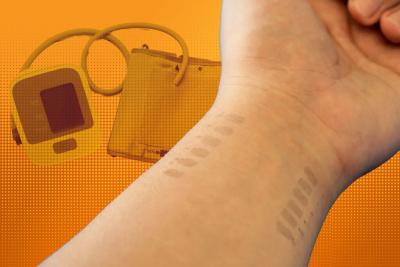Researchers at The University of Texas at Austin and Texas A&M University have developed a graphene-based electronic tattoo that can be worn on the wrist for hours and deliver continuous blood pressure measurements at an accuracy level exceeding nearly all available options on the market today. This could signify an alternative for the currently used cuff-based devices that constrict around the arm to give a reading, as well as improve accuracy levels.

The wearable is based on electrical bioimpedance and leverages atomically thin, self-adhesive, lightweight and unobtrusive graphene electronic tattoos as human bioelectronic interfaces. The graphene electronic tattoos are used to monitor arterial BP for >300âmin, a period tenfold longer than reported in previous studies.
The continuous monitoring of the e-tattoo allows for blood pressure measurements in all kinds of situations: at times of high stress, while sleeping, exercising, etc. It can deliver thousands of measurements more than any device thus far.
Mobile health monitoring has taken major leaps in recent years, primarily due to technology such as smartwatches. These devices use metallic sensors that get readings based on LED light sources shined through the skin.
However, leading smartwatches are not yet ready for blood pressure monitoring. That’s because the watches slide around on the wrist and might be far from arteries, making it hard to deliver accurate readings. And the light-based measurements can falter in people with darker skin tones and/or larger wrists.
E-tattoos make sense as a vehicle for mobile blood pressure monitoring because they reside in a sticky, stretchy material encasing the sensors that is comfortable to wear for long periods and does not slide around.
The newly developed device takes its measurements by shooting an electrical current into the skin and then analyzing the body’s response, which is known as bioimpedance. There is a correlation between bioimpedance and changes in blood pressure that has to do with blood volume changes. However, the correlation is not particularly obvious, so the team had to create a machine learning model to analyze the connection to get accurate blood pressure readings.
In medicine, cuff-less blood pressure monitoring is the holy grail, the researchers said, but there isn’t a viable solution on the market yet. It’s part of a larger push in medicine to use technology to untether patients from machines while collecting more data wherever they are, allowing them to go from room to room, clinic to clinic and still get personalized care.
All this data can help create a digital twin to model the human body, to predict and show how it might react and respond to treatments over time, Akinwande said.

